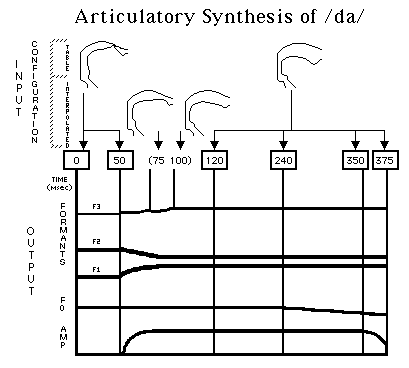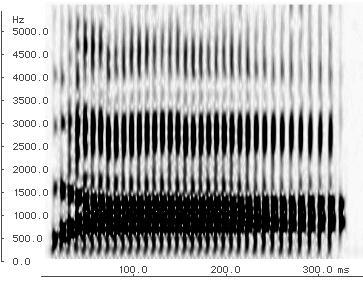Legacy: ASY: /da/ Synthesis
The figure above shows a schematic overview of the synthesis of /da/ in ASY. In this example, two key vocal tract shapes are used — specified as rows in the ASY script table. The first key shape (shown in rows 1 and 2 of the script table) is shown at the top left of the figure. This shape has the tongue tip raised to touch the alveolar ridge (behind the teeth). The second key shape (specified in rows 3-6 of the script table) is shown at the top right. Here the tract is in an /ah/ configuration, with the jaw dropped, and the mouth opened wide.
Critical events in the production of the /da/ are indicated by the boxes with numbers in them, which indicate critical time values, specified in msec. These time values are specified in the ASY control table. The onset of synthesis starts at time 0. During the first 50 msec., there is a short period of pre-voicing. The tract starts changing shape at time 50. During the next 70 msec. several intermediate tract shapes are generated by linear interpolation (a process similar to morphing). The figure shows two of these intermediate shapes. Movement of the tract has stopped by time 120. At time 240, the fundamental frequency (F0) starts to decline slowly, to allow for a natural sounding pitch contour. At time 350, amplitude is quickly ramped off. The production ends at time 375 msec.
The bottom half of the figure provides a schematic view of the output acoustics that are produced, including the first 3 formants (the major bands of energy in the signal, corresponding to the resonances of the vocal tract), the fundamental frequency (F0), and the overall energy (AMP).
Below is a figure showing an overlay of the moving frames of the vocal tract articulation for /da/, followed by a quick animation.
A characterization of the acoustic output of this /da/ synthesis can also be seen in a spectrogram. below, or can be listened to.
| Synthesis process | Tables | /banana/ example |
| ASY DEMO | VOWELS | VOCAL TRACT | DYNAMIC SYNTHESIS | INFORMATION |



